1.1: Introduction
( \newcommand{\kernel}{\mathrm{null}\,}\)
DISCUSSION
In this lab, you will become familiar with the use of the microscope (particularly oil immersion microscopy) and will compare the relative size and shape of various microorganisms.
A. BACTERIAL SHAPES, ARRANGEMENTS, AND FORMS
Bacteria are unicellular prokaryotic microorganisms (see Fig. 1.1.1) that divide by binary fission, a process by which one bacterium splits into two.

Video showing binary fission in bacteria
Video showing fluorescing inaging of binary fission in bacteria
There are three common shapes of bacteria:
- coccus
- bacillus
- spiral.
The cocci come in 5 different arrangements; the bacilli in 3 different arrangements; and the spirals in 3 different forms.
1. Coccus
A coccus-shaped bacterium is usually spherical, although some appear oval, elongated, or flattened on one side. Most cocci are approximately 0.5 - 1.0 micrometer (µm) in diameter and may be seen, based on their planes of division and tendency to remain attached after replication, in one of five arrangements: diplococcus, streptococcus, tetrad, sarcina, or staphylococcus. (See Fig. 1.1.2A.)
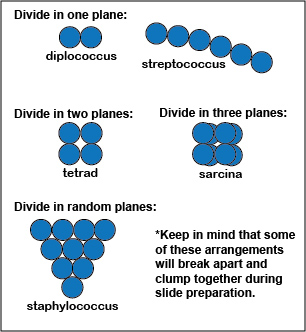
CC-BY-4.0 )
a. Division in one plane produces either a diplococcus or streptococcus. arrangement. (see Fig. 1.1.2A)
1. Diplococcus: a pair of cocci. (See Figs. 1.1.2B, 1.1.2C, and 1.1.2D.)
| Fig. 1.1.2B: Photomicrograph of a diplococcus | Fig. 1.1.2C: Scanning electron micrograph of a Streptococcus pneumoniae, a diplococcus. | Fig. 1.1.2D: Scanning electron micrograph of a Neisseria gonorrhoeae, a diplococcus |
|---|---|---|
 |
 |
.jpg?revision=1) |
| Note cocci in pairs (arrows). | Streptococcus pneumoniae is a common cause of ear infections, sinusitis, and pneumonia. | Neisseria gonorrhoeae causes gonorrhea. |
| (Copyright; Gary E. Kaiser, PhD, Professor of Microbiology CC-BY-4.0 ) | By Content Providers(s): CDC/ Janice Haney Carr [Public domain] Courtesy of the Centers for Disease Control and Prevention. | By NIAID (Neisseria gonorrhoeae Bacteria) [CC BY 2.0 (http://creativecommons.org/licenses/by/2.0)], via Wikimedia Commons |
2. Streptococcus: a chain of cocci. (See Figs. 1.1.2E, 1.1.2F, and 1.1.2G.)
|
Fig. 1.1.2E: Photomicrograph of a streptococcus |
Fig. 1.1.2F: Scanning electron micrograph of Streptococcus pyogenes |
Fig. 1.1.2G: Scanning electron micrograph of an Enterococcus species |
|---|---|---|
 |
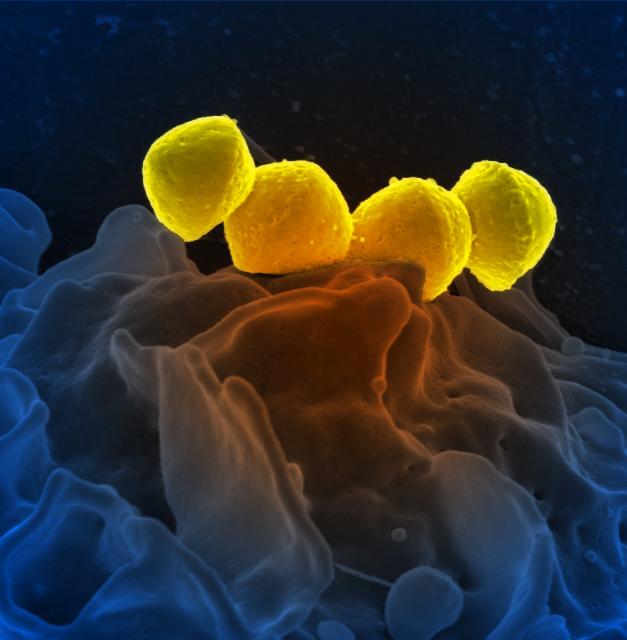 |
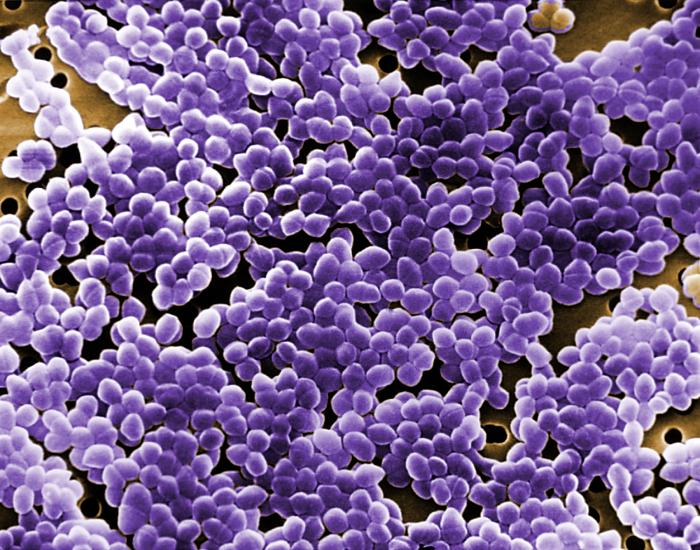 |
| This is Streptococcus pyogenes, the cause of strep throat. Note cocci in chains. | This bacterium causes strep throat. | Enterococcus species are common causes of healthcare-associated infections. |
| (Copyright; Gary E. Kaiser, PhD, Professor of Microbiology CC-BY-4.0 ) | By National Institutes of Health (NIH) (National Institutes of Health (NIH)) [Public domain], via Wikimedia Commons | By Content Providers(s): CDC/ Janice Haney Carr [Public domain]. Courtesy of the Centers for Disease Control and Prevention. |
b. Division in two planes produces a tetrad arrangement. (See Figs. 1.1.2A)
- Tetrad: a square of 4 cocci. (See Figs. 1.1.2H and 1.1.2I)
| Fig. 1.1.2H: Tetrad Arrangement: Indirect Stain | Fig. 1.1.2I: Scanning Electron Micrograph of Micrococcus luteus |
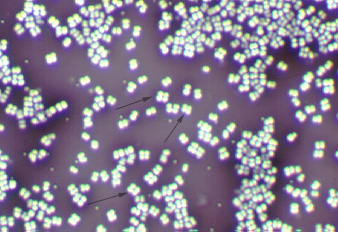 |
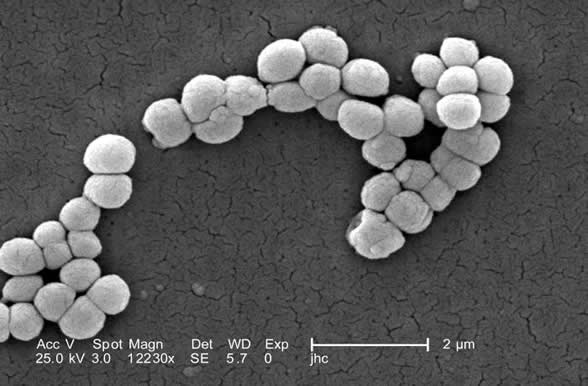 |
| A tetrad appears as a square of four cocci (arrows). It is difficult with a conventional light microscope to tell a tetrad arrangement (square of four cocci) from a sarcina arrangement (cube of eight) so in our lab, anytime you see a square of four cocci, say it is either a tetrad or a sarcina arrangement. | Several tetrads are visible. |
| (Copyright; Gary E. Kaiser, PhD, Professor of Microbiology CC-BY-4.0 ) | By Content Providers(s): CDC/Janice Haney Carr [Public domain]. Courtesy of the Centers for Disease Control and Prevention. |
c. Division in three planes produces a sarcina arrangement. (See Fig. 1.1.2A.)
Sarcina: A cube of eight cocci. (See Fig. 1.1.2J.)
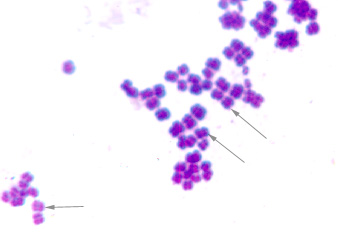
d. Division in random planes produces a staphylococcus arrangement (see Fig. 1.1.2A)
Staphylococcus: cocci in irregular, often grape-like clusters. See Figs. 1.1.2K 1.1.2L, and 1.1.2M.
|
Fig. 1.1.2K: Staphylococcus aureus |
Fig. 1.1.2L: Scanning electron micrograph of Staphylococcus aureus , a staphylococcus arrangement |
Fig. 1.1.2M: Scanning electron micrograph of methicillin-resistant Staphylococcus aureus (MRSA) |
|---|---|---|
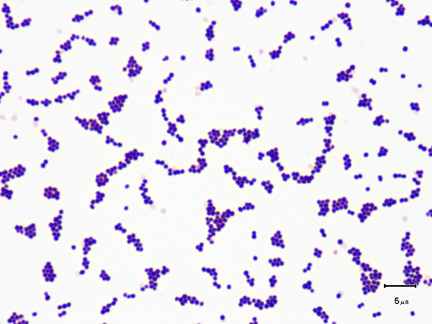 |
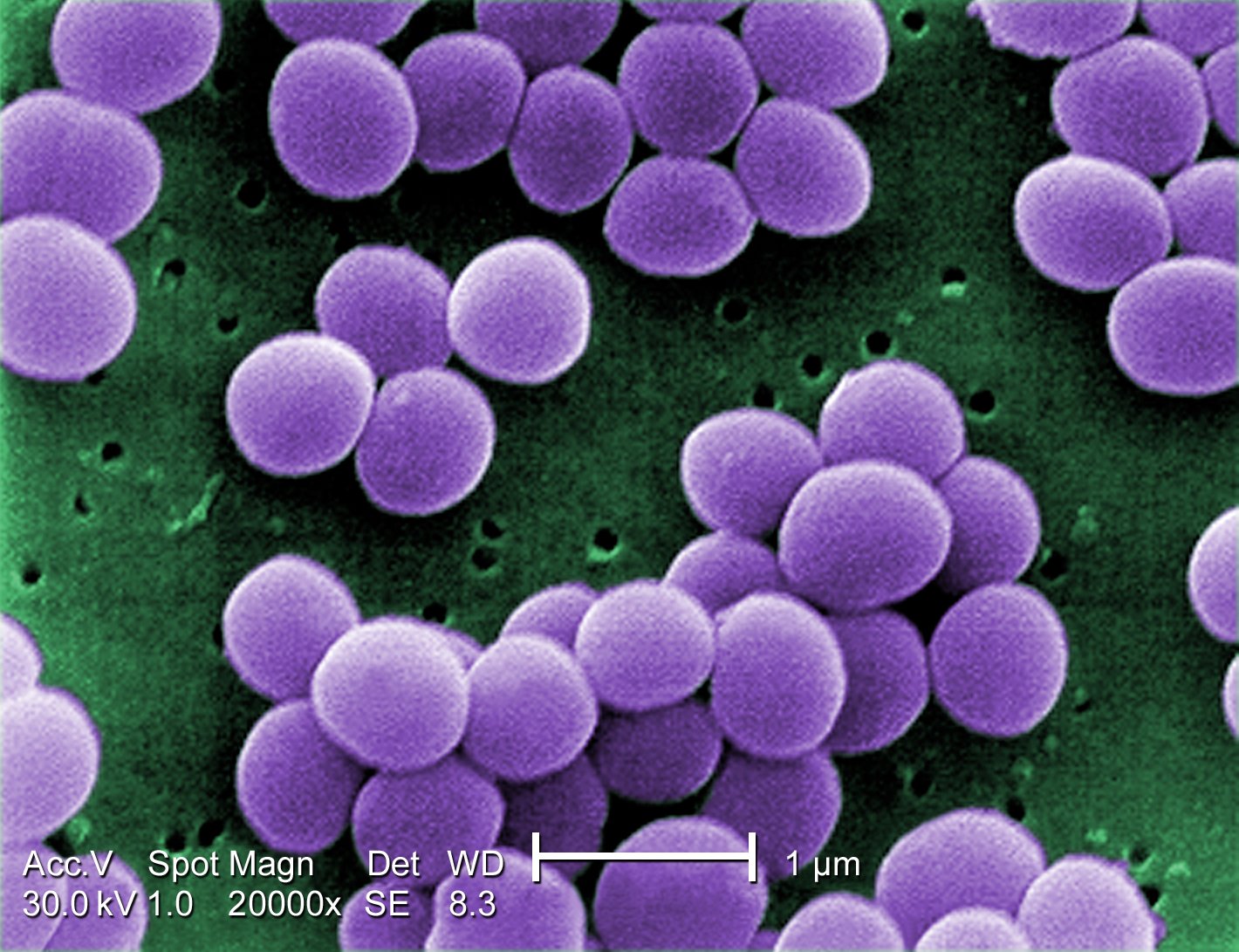 |
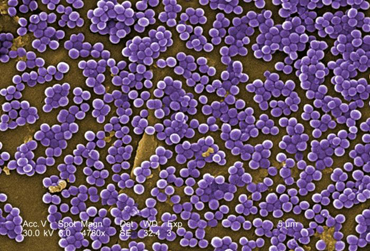 |
| Note staphylococcus arrangement (cocci in irregular, often grape-like clusters). Staphylococcus aureus is a common cause of skin abscesses, wound infections, and septicemia.. | Note staphylococcus arrangement (cocci in irregular, often grape-like clusters). Staphylococcus aureus is a common cause of skin abscesses, wound infections, and septicemia. | Note staphylococcus arrangement (cocci in irregular, often grape-like clusters). |
| (Copyright; Gary E. Kaiser, PhD, Professor of Microbiology CC-BY-4.0 ) | By National Institutes of Health (NIH) (National Institutes of Health (NIH)) [Public domain], via Wikimedia Commons | By Content Providers(s): CDC/ Janice Haney Carr [Public domain]. Courtesy of the Centers for Disease Control and Prevention. |
As you observe these different cocci, keep in mind that the procedures used in slide preparation may cause some arrangements to break apart or clump together (see Figs. 1D and 1E). The correct form, however, should predominate. Also remember that each coccus in an arrangement represents a complete, individual, one-celled organism
2. Bacillus (rod)
A bacillus or rod is a hot dog-shaped bacterium having one of three arrangements: bacillus, streptobacillus, or coccobacillus. (See Fig 1.1.3A.)

a. Bacillus: a single bacillus. (See Figs. 1.1.3B, 1.1.3C, and 1.1.3DB.)
|
Fig. 1.1.3B: Single bacillus (rod). |
Fig. 1.1.3C: Scanning electron micrograph of Pseudomonas aeruginosa, a bacillus. |
Fig. 1.1.3D: Scanning electron micrograph of Escherichia coli O157H7, a bacillus. |
|---|---|---|
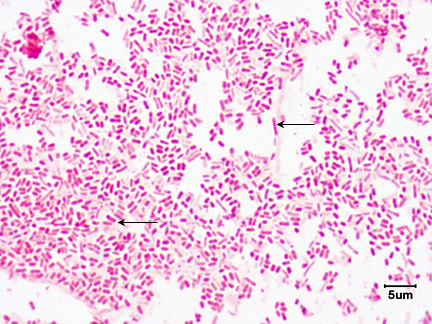 |
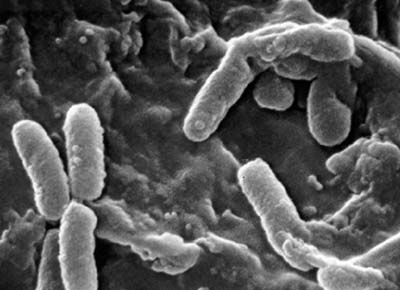 |
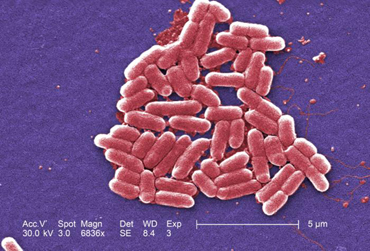 |
| Escherichia coli is the most common cause of urinary tract infections. | Pseudomonas aeruginosa is a common cause of healthcare-associated infections. | This is a diarrheagenic E. coli, also called shiga toxin-producing E. coli (STEC) |
| (Copyright; Gary E. Kaiser, PhD, Professor of Microbiology CC-BY-4.0 ) | By Content Providers(s): CDC/ Janice Haney Carr [Public domain]. Courtesy of the Centers for Disease Control and Prevention. | By Content Providers(s): CDC/ Janice Haney Carr [Public domain]. Courtesy of the Centers for Disease Control and Prevention. |
Streptobacillus: bacilli in chains. (See Figs. 1.1.3A and 1.1.3E.)

coccobacillus: oval and similar to a coccus. (See Figs. 3F and 3G.)
|
Fig. 1.1.3F: The Coccobacillus Acinetobacter |
Fig. 1.1.3G: Scanning electron micrograph of the coccobacillus Acinetobacter |
|---|---|
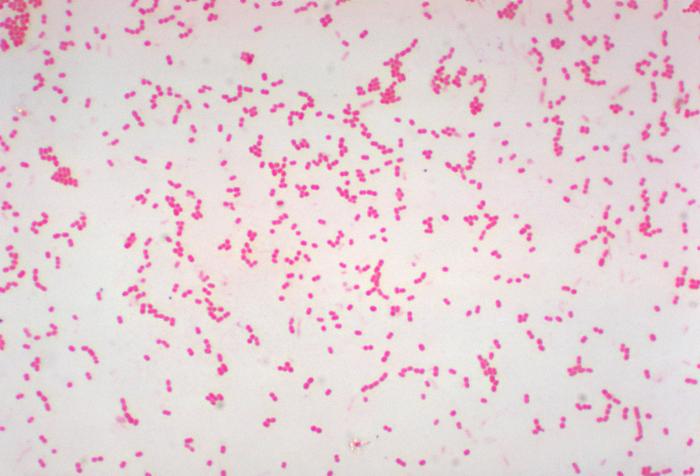 |
 |
| Note bacilli similar in size to cocci. | Note bacilli similar in size to cocci. |
| By Content Providers: CDC [Public domain]. The Centers for Disease Control and Prevention. |
By Content Providers(s): CDC/ Janice Haney Carr [Public domain]. Courtesy of the Centers for Disease Control and Prevention. |
A single bacillus is typically 0.5-1.0 µm wide and from 1- 4 µm long. Small bacilli or bacilli that are dividing or have just divided by binary fission may at first glance be confused for diplococci or cocci (see Fig. 1.1.3A.) so they must be observed carefully. You will, however, be able to see bacilli that have not divided and are definitely rod-shaped as well as bacilli in the process of dividing
3. Spiral
Spiral-shaped bacteria occur in one of three forms: vibrio, spirillum, or spirochete. (See Fig. 1.1.4A)

a. Vibrio: an incomplete spiral or comma-shaped (See Figs. 4A, 4B, and 4C.)
|
Fig. 1.1.4B: A vibrio |
Fig. 1.1.4C: Scanning Electron micrograph of Vibrio cholerae , a Vibrio |
|---|---|
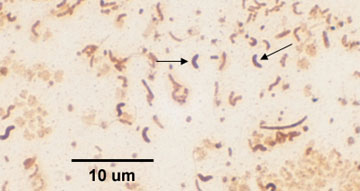 |
 |
| A vibrio appears as a curved bacillus (arrows). | This vibrio causes cholera. |
| (Copyright; Gary E. Kaiser, PhD, Professor of Microbiology CC-BY-4.0 ) | Information and public domain notice http://remf.dartmouth.edu/imagesindex.html Scanning electron microscope image of Vibrio cholerae bacteria, which infect the digestive system. Zeiss DSM 962 SEM T.J. Kirn, M.J. Lafferty, C.M.P Sandoe and R.K. Taylor. |
b. Spirillum: a thick, rigid spiral. (See Figs. 1.1.4A and 1.1.4D)

c. Spirochete: a thin, flexible spiral. (See Fig. 1.1.4A, 1.1.4E, 1.1.4F, and 1.1.4G.)
|
Fig. 1.1.4E: Treponema pallidum, a spirochete. |
Fig. 1.1.4F: Scanning electron micrograph of Leptospira interrogans, a spirochete. |
Fig. 1.1.4G: Scanning electron micrograph of Treponema pallidum, a spirochete. |
 |
 |
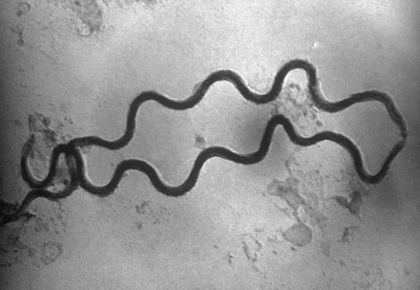 |
| This spirochete causes syphilis. | This spirochete causes leptospirosis. | This spirochete causes syphilis. |
| (Copyright; Gary E. Kaiser, PhD, Professor of Microbiology CC-BY-4.0 ) | By Content Providers(s): CDC/ Rob Weyant [Public domain]. Courtesy of the Centers for Disease Control and Prevention. | By Content Providers(s): CDC/ Janice Haney Carr [Public domain]. Courtesy of the Centers for Disease Control and Prevention. |
The spirals you will observe range from 5-40 µm long but some are over 100 µm in length. The spirochetes are the thinnest of the bacteria, often having a width of only 0.25-0.5 µm.
To view a nice interactive illustration comparing size of cells and microbes, see the Cell Size and Scale Resource at the University of Utah. (Genetic Science Learning Center. (2010, September 2) Cell Size and Scale. Retrieved October 19, 2017, from http://learn.genetics.utah.edu/content/cells/scale/ )
YouTube movie illustrating Size Comparison of Microorganisms created by Gracia Alvaro Montoya, MetaBallsStudios (MBS), United Kingdom, Nov., 2017
B. YEASTS
Yeasts, such as the common baker's yeast Saccharomyces cerevisiae (see Fig. 1.1.5A), are unicellular fungi. They usually appear spherical and have a diameter of 3 - 5 µm. Yeasts commonly reproduce asexually by a process called budding. (see Figs. 1.1.5B and 1.1.5CA) Unlike bacteria, which are prokaryotic, yeasts are eukaryotic (see Fig. 5D).
|
Fig. 1.1.5A: Direct Stain of Saccharomyces cerevisiae |
Fig. 1.1.5B: Direct stain of Candida albicans |
Fig. 1.1.5C: Scanning electron micrograph of Saccharomyces cerevisiae |
Fig. 1.1.5D: Transmission electron micrograph of Candida albicans, a eukaryotic cell. |
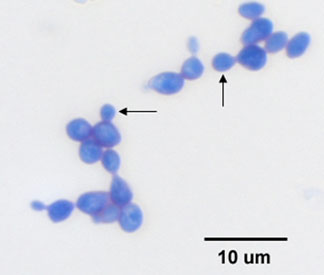 |
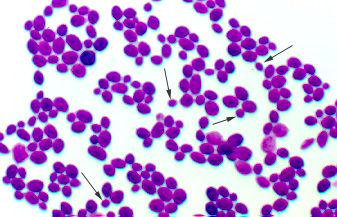 |
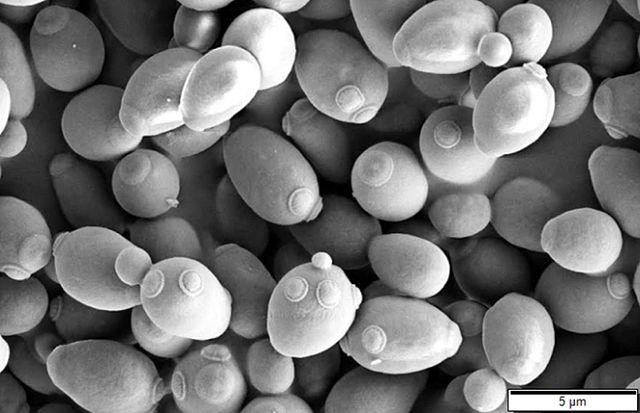 |
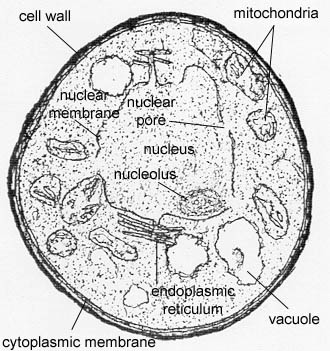 |
| Note budding yeast (arrows) | Note budding yeast (arrows) | Note budding yeast (arrows) | Note the eukaryotic cellular structures. |
| (Copyright; Gary E. Kaiser, PhD, Professor of Microbiology CC-BY-4.0 ) | (Copyright; Gary E. Kaiser, PhD, Professor of Microbiology CC-BY-4.0 ) | By Mogana Das Murtey and Patchamuthu Ramasamy - [1], CC BY-SA 3.0, https://commons.wikimedia.org/w/inde...curid=52254246 | (Copyright; Gary E. Kaiser, PhD, Professor of Microbiology CC-BY-4.0 ) |
To view a nice interactive illustration comparing size of cells and microbes, see the Cell Size and Scale Resource at the University of Utah. (Genetic Science Learning Center. (2010, September 2) Cell Size and Scale. Retrieved October 19, 2017, from http://learn.genetics.utah.edu/content/cells/scale/ )
Contributors and Attributions
Dr. Gary Kaiser (COMMUNITY COLLEGE OF BALTIMORE COUNTY, CATONSVILLE CAMPUS)



